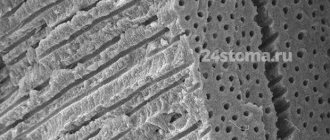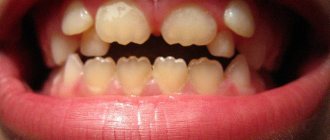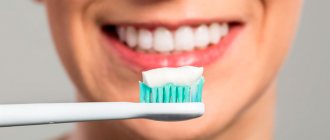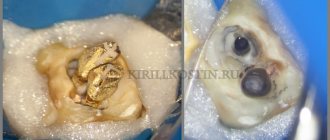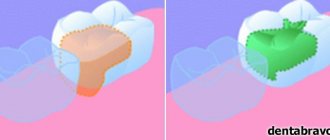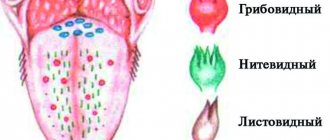The dentofacial system is closely connected with the facial and masticatory muscles and is innervated by the trigeminal nerve. It consists of the periodontal apparatus, teeth, the temporomandibular joint and its ligamentous apparatus, muscles above and below the hyoid bone, tongue, muscles responsible for facial expressions, neck muscles, blood vessels and nerves. The norm is when all these structures work harmoniously and without damage.
Usually, when eating food, the receptors in the oral cavity transmit information about the state of the food to the central nervous system - if the food has not yet been crushed sufficiently for swallowing, the nervous system sends impulses to the masticatory muscles to continue grinding. The nervous system of the teeth sends signals by which the masticatory muscles determine the strength of contractions.
If, when chewing, the receptors receive information that the pressure and, accordingly, the contact of the teeth is too strong, then the central nervous system sends signals to the muscles and the degree of pressure decreases, due to which too strong traumatic loads on the periodontium and TMJ disappear.
The basics of gnathology can be considered that the norm is when the lower jaw joint, muscles and teeth closure work in harmony and do not create too much stress on the body systems. Accordingly, if the load is still too strong, an examination is necessary to find the cause and treatment.
Rozhkov I.A. Dental units “ANTOS” - a new model range of the “A” series are already in Russia!
Problems of “Clinical Gnathology”
Gnathology is the science of the interaction of all organs of the dentofacial system, including anatomy, physiology, and pathophysiology of this system, involving a comprehensive study, diagnosis and planning of treatment measures.
"Clinical Gnathology" implies an emphasis on the practical use of this science.
Over the past 20 years, there has been a technological breakthrough in domestic dentistry: new materials have appeared, and modern, high-quality, aesthetically pleasing dentures have begun to be used. Why is the number of patient complaints about dental care increasing and currently, according to forensic data, is one of the first places among complaints brought against doctors of various specialties?
We believe that one of the reasons for this situation is insufficient attention to the problems of Gnathology.
Based on clinical observations, back in the 80s we described numerous dental and neurological symptoms that arise as a result of diagnostic and treatment errors. The first works were published on the problems of “Clinical Gnathology”, on electromyography of masticatory muscles in normal and pathological conditions, on phonography and tomography (and later computed tomography) of the temporomandibular joint. Our use of intra- and extraoral recording of movements of the lower jaw improved the diagnosis of functional disorders and made it possible to imagine their pathogenesis.
For the diagnosis and design of dentures, we first mastered and used articulators in practice (1982-1983).
Unfortunately, in those years, new developments had difficulty making their way into practice. This was also facilitated by the fact that there was no Gnathology in dental training programs at universities. Textbooks still contain long-outdated materials on “Biomechanics of the masticatory apparatus.” There is no special textbook on “Clinical Gnathology”.
The domestic industry does not produce instruments and devices for studying the function of the dentofacial system or simulating the movements of the lower jaw.
In Europe and throughout the world, much attention is paid to the development of Gnathology. Dental companies produce numerous devices and articulators. All countries have books and teaching aids on this topic. Many educational institutions abroad have programs in Gnathology, designed for several years of study. They are implemented throughout the entire learning process or in special courses and departments.
Advanced courses in Gnathology are available in many European Universities. The best of them are considered to be the courses taught by professors A.Gutowski (Germany) and R.SIavicek (Austria).
At international exhibitions (Cologne) a variety of pantographs (mechanical and electronic), articulators of all types and for various purposes are constantly demonstrated.
Knowledge of “Clinical Gnathology” is necessary for a dentist of any profile:
— to assess occlusion in normal and pathological conditions;
— for the diagnosis and treatment of muscular-articular dysfunction, diseases of the temporomandibular joint, facial pain;
— to create stable central occlusion for all types of occlusal correction (orthopedic, orthodontic, orthognathic surgery);
— for planning functional occlusion in the manufacture of orthopedic structures;
— to assess the effect of occlusal trauma on the periodontium;
— for repositioning jaw fragments in accordance with correct occlusion;
— to determine the location and direction of the implant;
— when choosing a treatment method and determining a plan for medical interventions;
- to evaluate records of movements of the lower jaw and compare these records with other indicators of the functional analysis of the dentofacial system.
Several years ago, on the initiative of StAR, an educational and advisory and “Professor's Author's” clinic was organized, where we compiled a program for advanced training of doctors and dental technicians in “Clinical Gnathology” (headed by V.D. Wagner).
Classes at the organized training center aroused great interest among dentists. Doctors from many private clinics and offices, university teachers repeatedly attend these classes and use the acquired knowledge in practice.
We associate the further development of “Clinical Gnathology” with publications in the corresponding section of the “Maestro” magazine, as well as with the planned organization of the “Clinical Gnathology” section under the auspices of StAR. It is necessary to create “Clinical Gnathology” departments in universities and advanced training faculties for doctors.
An important matter is the introduction into the curriculum of dental departments and schools of the basics of “Clinical Gnathology”, a section on the peculiarities of working with articulators, on new methods of modeling the occlusal surface, setting teeth, etc.
In Russia and the CIS countries there are only a few specialists on this problem, and they interpret the same concepts and treatment methods differently, sometimes they do not have basic knowledge of Gnathology, patients receive conflicting advisory opinions, which is often the source of iatrogenic diseases.
Standards are required for “Clinical Gnathology” as a general dental discipline (such disciplines include, for example, anesthesiology, dental neurology, medical psychology, etc.). This means that a specialist dealing with the problems of “Clinical Gnathology” must have:
— dental unit, office;
— necessary equipment (face bows, articulator, pantograph, funciograph, etc.), materials (gypsum No. 3,4, special wax, molds for casting models), etc.;
— experience working with patients with occlusion disorders, temporomandibular joint disorders, bruxism, facial pain;
— document confirming completion of courses in Clinical Gnathology.
It is also advisable to create courses on “Clinical Gnathology”, for example, at the departments of general dental practice, where classes could be conducted with students, as well as train teachers in this discipline (personnel for personnel).
I urge the public to take part in creating a scenario for the formation of “Clinical Gnathology” as a general dental discipline.
Best regards, Prof. V.A. Khvatova
Components of the dental system and what they are needed for
Teeth can be roughly divided into front and side teeth. The front teeth are responsible for biting, and the lateral teeth are equipped with special tubercles and are responsible for grinding food during chewing.
The teeth are covered with enamel - this is the hardest tissue of the body and it is this that protects the teeth under stress.
The pressure from chewing is transferred to the periodontium - these are the tissues surrounding the tooth and providing it with an elastic connection to the jaw bone. The tooth itself is attached to the bone with the help of a ligamentous apparatus, and it is due to this that each tooth has physiological mobility - due to this, the tooth is more stable and less susceptible to overload.
Also, the periodontium is filled with blood and lymphatic vessels and nerves, thanks to which it controls the degree of chewing pressure and can “program” the position of the lower jaw by regulating this pressure.
With short-term overloads, the periodontium, as a rule, does not undergo changes. But if overload affects it for a long time, this can lead to unpleasant consequences.
A very important factor is the psychological state of the patient.
An unstable psychological state reduces tissue resistance and can lead to:
- Compression (squeezing)
- Distractions (stretching)
Compression leads to a decrease in the distance inside the joint and traumatization of the articular disc and cartilaginous surfaces, but the articular capsule and ligaments of the joint do not experience increased stress.
With distraction, on the contrary, the joint space becomes wider, and the capsule and ligaments of the joint are stretched.
Compression
The causes of compression are the loss of chewing teeth, pathological abrasion or disruption of closure after orthopedic operations on chewing teeth.
In this case, the basics of clinical gnathology suggest correcting compression using various types of onlays on the lateral teeth.
At the beginning, with compression, the patient may notice incomplete opening of the mouth and clicking when opening the mouth wide, and over time this can lead to premature wear of the articular disc and inflammation of the cartilaginous surfaces of the joint and, ultimately, pain with any movement.
When is it necessary to contact a gnathologist?
There is no need to constantly visit a gnathologist. The attending dentist can refer you to such a specialist if he has identified some problems with the condition of the dentofacial apparatus.
Consultation with a gnathologist-dentist may be required before orthodontic and orthopedic dental treatment.
What indications does clinical gnathology have:
- dysfunction of the temporomandibular joint;
- osteoarthritis, TMJ osteoarthritis;
- incomplete closure of the dentition;
- the appearance of dental anomalies;
- anatomically incorrect position of the jaws;
- numerous cracks in tooth enamel;
- pain in the jaw and neck area of unknown etiology;
- grinding of teeth (bruxism).
PRINCIPLES FOR SECURITY OF PERSONAL DATA
3.1. The main task of ensuring the security of personal data during their processing in the Organization is to prevent unauthorized access to it by third parties, to prevent intentional software, hardware and other influences for the purpose of stealing personal data, destruction (destruction) or distortion of them during processing.
3.2. To ensure the security of personal data, the Organization is guided by the following principles:
- legality: protection of personal data is based on the provisions of regulatory legal acts and methodological documents of authorized state bodies in the field of processing and protection of personal data;
- systematic: PD processing in the Organization is carried out taking into account all interconnected, interacting and time-varying elements, conditions and factors that are significant for understanding and solving the problem of ensuring PD security;
- comprehensiveness: PD protection is built using the functionality of information technologies implemented in the Organization’s information systems and other systems and protection means available in the Organization;
- continuity: PD protection is ensured at all stages of their processing and in all modes of operation of PD processing systems, including during repair and routine maintenance;
- timeliness: measures to ensure an adequate level of PD security are taken before the start of their processing;
- continuity and continuity of improvement: modernization and expansion of measures and means of protecting personal data is carried out based on the results of an analysis of the practice of processing personal data in the Organization, taking into account the identification of new ways and means of implementing threats to the security of personal data, domestic and foreign experience in the field of information protection;
- personal responsibility: responsibility for ensuring the security of personal data rests with the Employees within the limits of their responsibilities related to the processing and protection of personal data;
- minimization of access rights: access to personal data is provided to Employees only to the extent necessary to perform their job duties;
- flexibility: ensuring the fulfillment of personal data protection functions when the characteristics of the functioning of the Organization’s personal data information systems, as well as the volume and composition of processed personal data change;
- specialization and professionalism: the implementation of measures to ensure the security of personal data is carried out by Employees who have the necessary qualifications and experience;
- efficiency of personnel selection procedures: the Organization’s personnel policy provides for careful selection of personnel and motivation of Employees, allowing to eliminate or minimize the possibility of them violating the security of personal data;
- observability and transparency: measures to ensure the security of personal data must be planned so that the results of their application are clearly observable (transparent) and can be assessed by those exercising control;
- continuity of monitoring and evaluation: procedures for continuous monitoring of the use of PD processing and protection systems are established, and the results of monitoring are regularly analyzed.
3.3. The Organization does not process PD that is incompatible with the purposes of its collection. Unless otherwise provided by federal law, upon completion of personal data processing in the Organization, including when the goals of their processing are achieved or the need to achieve these goals is no longer necessary, the personal data processed by the Organization will be destroyed or depersonalized.
3.4. When processing personal data, their accuracy, sufficiency, and, if necessary, relevance in relation to the purposes of processing are ensured. The organization takes the necessary measures to delete or clarify incomplete or inaccurate personal data.
Chewing load
The TMJ has three sections that perceive chewing load:
- Articular tubercle - it is located on the temporal bone and is well responsive to pressure when chewing.
- Articular disc. In the central part, to which most of the chewing pressure is transmitted, the disc has no vessels.
- Cartilage tissue that covers the surfaces of joints.
The main direction of pressure when chewing is forward and upward.
With normal muscle condition and coordinated work, we get smooth movement in the joint without overload. To have an idea of muscle function and joint condition, additional research is necessary. The most informative are rheoartography, tomography and magnetic resonance imaging.
If the joint works normally and smoothly, then most of the load during chewing is transferred to the periodontium. It is he who gives the central nervous system feedback on the strength of muscle work.
Despite the fact that most information comes from the lateral chewing teeth and their periodontium, it is not necessary that any disturbances in this department will lead to pathological conditions of the joint and muscles.
Basic diagnostic methods
Since a gnathologist works with patients who have mixed pathology affecting several body systems, there are more than enough diagnostic methods in gnathology. To make an accurate diagnosis, gnathologists use:
- X-ray. Allows you to determine the presence of organic changes in the structures of the dentofacial apparatus;
- MRI, CT. More informative methods allow one to assess the condition of tissues and the presence of even minor pathological changes in them.
- Orthopantomography. Used for a comprehensive assessment of the condition of the upper and lower jaw, the presence of changes in bone tissue.
- Dopplerography. To study the condition of blood vessels and diagnose disturbances in the blood supply to the structures of the dental system.
- Electromyography. Allows you to evaluate the function of the muscular system.
Also, when making a diagnosis, consultations with related specialists may be prescribed. The patient is examined by a neurologist, vertebrologist, and if necessary, a consultation with a maxillofacial surgeon is scheduled (in the presence of injuries or developmental anomalies). Also, in some cases, problems with the dental system can be psychological in nature and be provoked by chronic stress, which is accompanied by prolonged spasm of various muscle groups.
Basic treatment methods
Treatment by a gnathologist is aimed at eliminating the underlying cause of symptoms and improving the patient’s quality of life. If necessary, treatment of concomitant diseases is carried out by appropriate specialists. For example, for osteochondrosis of the cervical spine, massage and therapeutic exercises have a good effect, and for lesions of the trigeminal nerve, drug treatment prescribed by a neurologist.
An important place in treatment by a gnathologist is occupied by the use of special splints, mouth guards, and trainers, which help relieve muscle tension and form the correct relationship between the different anatomical structures of the dental system. In some cases, only surgical intervention can significantly help the patient, which will effectively correct existing abnormalities.
Information about who a gnathologist is and what gnathology is helps patients understand which specialist they can turn to for help when a regular consultation with a dentist does not bring the desired results. If your attending physician refers you to a gnathologist, then be sure to undergo an examination by this specialist, strictly follow all the recommendations, and soon you will notice a significant improvement in your condition.
Sincerely, Levin D.V., chief physician
